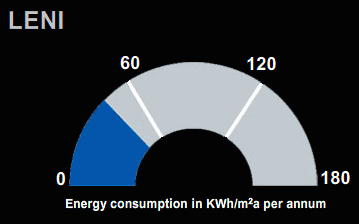The Lighting Energy Numeric Indicator

The Lighting Energy Numeric Indicator (LENI) features within EN 15193, which specifies the calculation methodology and introduces LENI for certification purposes. The LENI relies on a calculation that outputs the kilowatts per hour per metre squared (kWh/m2). This differs from current UK legislation (Part L) which prefers to calculate efficiency of a lighting system in Lumens per Watt and / or Watts per Metre Sq (W/M2).
The fundamental difference between these methods of working out efficiency is that Part L is concerned with how efficient a luminaire is and how much energy the total installation uses, while LENI is concerned with how efficient the entire installation is, inclusive of lighting controls. To apply ‘diversity’ to the load on a control system due to dimmed luminaires surely makes sense, yet it has been resisted until now.
With all the talk about global warming there’s a growing awareness of the need for effective lighting control as part of an energy reduction strategy in buildings. Almost 20% of energy use worldwide goes into lighting applications, and in some cases such as retail, lighting can use more than 40% of the total energy demand.
Building on the role of lighting controls are the energy targets from EN12464:1. These are based on LENI and are widely accepted by the lighting community as the best metric to evaluate energy use for lighting. This sets benchmark figures and compliance targets in line with the Energy Performance in Buildings Directive. The targets should work in favour of lighting designers, as they will encourage design-led solutions, tailored to the individual building, rather than the blanket approach we currently have.
Liz Peck, Secretary of the Society of Light & Lighting recently said in a Lux Magazine article:
“We must move away from luminaire efficiency and look to design-led solutions based on energy consumption – it’s widely recognised that luminaire efficiency can only be driven so far, so we should change the way we measure efficiency now. Enough people have lamented this aspect of Part L over the years and what’s needed now is for those people to support the SLL and its industry partners in making our case to the DCLG. It’s time to act.”
The new edition of Part L is due in 2013. The period for lobbying has therefore passed, as the consultation paper is due in December 2011. Let’s hope the government has listened!
For further information follow these links:
https://archive.luxmagazine.co.uk/2011/05/act-now-to-change-part-l-‘absurdity’-says-sll/
https://www.thornlighting.com/holding/microsites/education_microsite_uk/leni.html
Image: © James French


